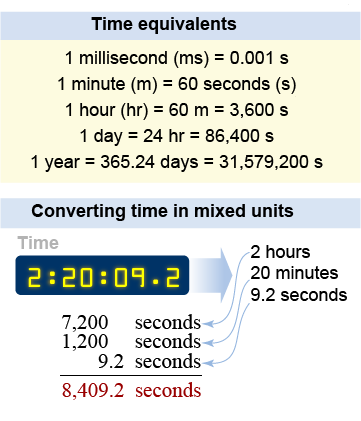|
 How things change over time is a basic question in all of science, including physics. Time is a fundamental quantity and there are two different ways to think about it. In your daily life, the word “time” usually means historical time, such as 2:25 pm. Historical time assigns a particular value to each successive moment of the past, present, and future. Clocks read historical time, as do calendars and bus schedules. Historical time has no known end, but scientists believe there is a beginning to historical time, roughly 13.6 billion years ago when the universe exploded forth in the Big Bang.
How things change over time is a basic question in all of science, including physics. Time is a fundamental quantity and there are two different ways to think about it. In your daily life, the word “time” usually means historical time, such as 2:25 pm. Historical time assigns a particular value to each successive moment of the past, present, and future. Clocks read historical time, as do calendars and bus schedules. Historical time has no known end, but scientists believe there is a beginning to historical time, roughly 13.6 billion years ago when the universe exploded forth in the Big Bang. 
|
Historical time rarely appears in physics. Instead, physics deals mainly with time intervals, usually in seconds. A time interval is a quantity of time, such as 10 seconds or 3 hours. A stopwatch is a device that measures a time interval. Time intervals are independent of when they occur historically; ten seconds at 9:00 am on Tuesday is the same amount of time as ten seconds at 5:00 pm on Friday. This is important because the laws of physics cannot depend on what time it is! 
|
The second is the fundamental unit of time in both the English and the SI systems. A single second is about the time it takes to say “one thousand.” There are 60 seconds in a minute, 3,600 seconds in an hour, and 86,400 seconds in one day. Prior to 1967, the second was defined as 1/86,400 of an average day. The standard definition of the second was changed in 1967 to be the time it takes a certain frequency of light emitted by a cesium-133 atom to perform 9,192,631,770 complete oscillations. 
|
Physics calculations require that time be expressed in a single unit, usually seconds. Time, however, is often expressed in mixed units—using a combination of years, days, hours, minutes, and/or seconds. A race time of 2 hours, 20 minutes, and 9.2 seconds is an example of mixed units. You cannot do calculations with time in mixed units! Before calculating any quantity in physics all values for time must be in a single unit. 
| 
|
To convert time to hours, you convert each partial quantity—such as 20 minutes—to seconds. Then add up all the partial time intervals. Two hours is 7,200 seconds and 20 minutes is 1,200 seconds. Summing up the hours, minutes, and seconds in the example (at right) gives a race time of 8,409.2 seconds. 
|
How long is 3 hours, 17 minutes in seconds? - 11,820 s
- 10,800 s
- 3,600 s
- 1,020 s
 |
The correct answer is a, 11,820 s.
3 hours is 10,800 s and 17 minutes is 1,020 s. 
|
| |
|

